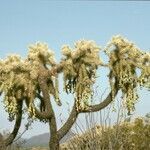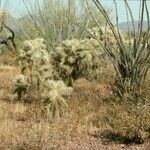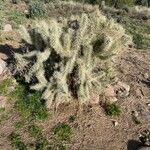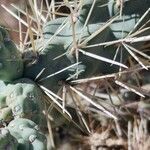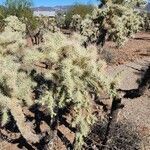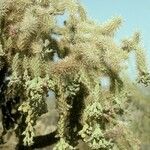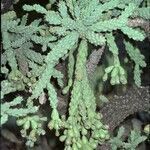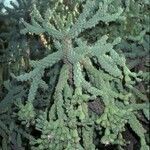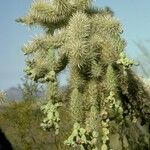Trees 1-3 m; trunk divaricately branching; crown many branch-ed, spreading. Stem segments whorled or subwhorled, gray-green, often drying blackish, ± spiny throughout, terminal ones easily dislodged, 6-16(-23) × 2-3.5 cm; tubercles salient, broadly oval, 0.8-1.3(-1.9) cm; areoles obdeltate, 5-7(-10) × 2.5-4 mm; wool gold to tan, aging gray to black. Spines 0-12(-18) per areole, at most areoles to nearly absent, yellowish, sometimes also pale pinkish, aging brown, interlaced or not with spines of adjacent areoles; abaxial spines erect to deflexed, spreading, flattened basally, the longest to 3.5 cm; adaxial spines erect or spreading, terete to subterete, longest to 2.5 cm; sheaths uniformly whitish, yellowish to golden, baggy. Glochids in adaxial tuft, sometimes also scattered along areole margins, yellow, 1-3 mm. Flowers: inner tepals usually reflexed, pink to magenta, obovate to ligulate, 12-16 mm, apiculate emarginate; filaments pale pink to magenta; anthers white to cream; style pinkish; stigma lobes whitish to pale yellow. Fruits proliferating, forming long, branching, pendent chains, at maturity gray-green, often stipitate, obconic, fleshy, shallowly tuberculate, usually spineless; basal fruits 32-55 × 23-45 mm; terminal fruits 2-3.3 × 1.3-2.3 cm; tubercles becoming obscure; umbilicus to 8 mm deep; areoles 18-35. Seeds pale yellow to brownish, angular to very irregular in outline, warped, 1.9 × 1.5-3.5 mm, sides with 1-2 large depressions, hilum pointed; girdle smooth.
More
A cactus. It is like a tree. It has many branches and a spreading crown. It is 1-3 m high. The trunks are branching. The stem segments are spiny all over. They are grey-green but turn blackish. The end segments are easily removed. They are 6-23 cm long and 2-3.5 cm wide. The flowers are pink to red and open in the late afternoon. The fruit are a cone shape and in long chains hanging down. They are fleshy, grey-green and almost without spines. They are 2-5.5 cm long by 1.3-4.5 cm wide.
See Cylindropuntia fulgida var. mamillata (A.Schott ex Engelm.) Backeb. for description of variety occurring in Australia.
The fruit are eaten raw. They can also be used in jellies and drinks. The buds, fruit and joints are baked in a pit then eaten. A gummy sap from the stem can be eaten raw. It is also boiled, roasted or mixed with water to make a drink.

